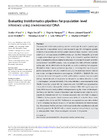Evaluating bioinformatics pipelines for population-level inference using environmental DNA
dc.contributor.author
Macé, Bastien
dc.contributor.author
Hocdé, Régis
dc.contributor.author
Marques, Virginie
dc.contributor.author
Guerin, Pierre-Edouard
dc.contributor.author
Valentini, Alice
dc.contributor.author
Arnal, Véronique
dc.contributor.author
Pellissier, Loïc
dc.contributor.author
Manel, Stéphanie
dc.date.accessioned
2022-06-08T08:11:51Z
dc.date.available
2022-06-05T03:00:29Z
dc.date.available
2022-06-08T08:11:51Z
dc.date.issued
2022-05
dc.identifier.issn
2637-4943
dc.identifier.other
10.1002/edn3.269
en_US
dc.identifier.uri
http://hdl.handle.net/20.500.11850/550930
dc.identifier.doi
10.3929/ethz-b-000550930
dc.description.abstract
Environmental DNA is mainly not only used at the interspecific level, to quantify species diversity in ecosystems, but can also be used to quantify intraspecific genetic variability, thus avoiding the need to sample individual tissue. However, errors in the amplification and sequencing of eDNA samples can blur this intraspecific signal and strongly over-estimate genetic diversity. Existing bioinformatics pipelines therefore need to be tested to evaluate whether reliable levels of intraspecific genetic variability can be derived from eDNA samples. Here, we compare the ability of twelve metabarcoding pipelines to detect intraspecific genetic variability combining five programs. All pipelines have common pre-processing steps, a processing data step using programs among obiclean; DADA2; SWARM; and LULU. An additional chimera removal step is also investigated based on two programs (VSEARCH or DADA2). The case study was the natural intraspecific variation within Mullus surmuletus in experimental settings. We developed specific primers for this species, located on the mitochondrial D-loop fragment (barcode MS-DL06). Thirty-nine individuals were collected from the Mediterranean Sea, placed into four aquariums, and their DNA was sequenced on this marker to build an intraspecific reference database. After filtering the aquarium water, DNA was extracted, amplified, and sequenced using the primer pair developed. We then quantified the number of true haplotypes returned by each pipeline and its capacity to eliminate most of the erroneous sequences. We show that the program DADA2 with a two-parent chimeric sequence removal step is the best tool to estimate intraspecific diversity from eDNA. Furthermore, our approach was also able to detect true M. surmuletus haplotypes in two eDNA samples collected in the Mediterranean Sea. We conclude that the combination of an appropriate intrapopulation barcode and a denoising pipeline like DADA2 with a chimeric sequence removal step is promising to make population-level inference using environmental DNA possible.
en_US
dc.format
application/pdf
en_US
dc.language.iso
en
en_US
dc.publisher
Wiley
en_US
dc.rights.uri
http://creativecommons.org/licenses/by/4.0/
dc.subject
bioinformatics
en_US
dc.subject
environmental DNA
en_US
dc.subject
fish
en_US
dc.subject
genetic diversity
en_US
dc.subject
marine ecology
en_US
dc.title
Evaluating bioinformatics pipelines for population-level inference using environmental DNA
en_US
dc.type
Journal Article
dc.rights.license
Creative Commons Attribution 4.0 International
dc.date.published
2022-02-08
ethz.journal.title
Environmental DNA
ethz.journal.volume
4
en_US
ethz.journal.issue
3
en_US
ethz.pages.start
674
en_US
ethz.pages.end
686
en_US
ethz.version.deposit
publishedVersion
en_US
ethz.identifier.scopus
ethz.publication.place
Hoboken, NJ
en_US
ethz.publication.status
published
en_US
ethz.leitzahl
ETH Zürich::00002 - ETH Zürich::00012 - Lehre und Forschung::00007 - Departemente::02350 - Dep. Umweltsystemwissenschaften / Dep. of Environmental Systems Science::02722 - Institut für Terrestrische Oekosysteme / Institute of Terrestrial Ecosystems::09553 - Pellissier, Loïc / Pellissier, Loïc
ethz.leitzahl.certified
ETH Zürich::00002 - ETH Zürich::00012 - Lehre und Forschung::00007 - Departemente::02350 - Dep. Umweltsystemwissenschaften / Dep. of Environmental Systems Science::02722 - Institut für Terrestrische Oekosysteme / Institute of Terrestrial Ecosystems::09553 - Pellissier, Loïc / Pellissier, Loïc
ethz.date.deposited
2022-06-05T03:00:31Z
ethz.source
SCOPUS
ethz.eth
yes
en_US
ethz.availability
Open access
en_US
ethz.rosetta.installDate
2022-06-08T08:11:59Z
ethz.rosetta.lastUpdated
2023-02-07T03:25:58Z
ethz.rosetta.versionExported
true
ethz.COinS
ctx_ver=Z39.88-2004&rft_val_fmt=info:ofi/fmt:kev:mtx:journal&rft.atitle=Evaluating%20bioinformatics%20pipelines%20for%20population-level%20inference%20using%20environmental%20DNA&rft.jtitle=Environmental%20DNA&rft.date=2022-05&rft.volume=4&rft.issue=3&rft.spage=674&rft.epage=686&rft.issn=2637-4943&rft.au=Mac%C3%A9,%20Bastien&Hocd%C3%A9,%20R%C3%A9gis&Marques,%20Virginie&Guerin,%20Pierre-Edouard&Valentini,%20Alice&rft.genre=article&rft_id=info:doi/10.1002/edn3.269&
Files in this item
Publication type
-
Journal Article [128972]

